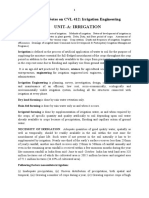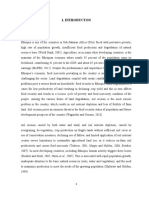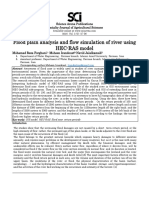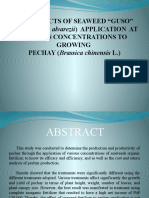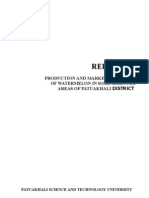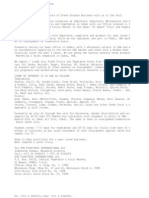Efficiencies and Water Losses of Irrigation Systems
Efficiencies and Water Losses of Irrigation Systems
Uploaded by
Aziz Khan KakarCopyright:
Available Formats
Efficiencies and Water Losses of Irrigation Systems
Efficiencies and Water Losses of Irrigation Systems
Uploaded by
Aziz Khan KakarCopyright
Available Formats
Share this document
Did you find this document useful?
Is this content inappropriate?
Copyright:
Available Formats
Efficiencies and Water Losses of Irrigation Systems
Efficiencies and Water Losses of Irrigation Systems
Uploaded by
Aziz Khan KakarCopyright:
Available Formats
Efficiency ratings receive a lot of attention. We like efficient engines, air conditioners, water heaters and furnaces.
Conservationists like efficient water systems that deliver water for its intended use without loss due to leakage, spills or contamination. Since irrigation is the largest appropriated water user in Kansas, irrigation systems also receive merit based on how efficient they are reported to be. While this might sound straightforward and simple, there is room for confusion because there are different ways to define efficiency. Efficiencies also vary in time and with management. Very efficient systems by some definitions can be very poor performers by other definitions, for example, if distribution uniformity and delivery amount are inadequate to fulfill crop need. This bulletin will define and explain several common efficiency terms in use for irrigation systems and show how these terms apply to some common irrigation situations.
DEFINITIONS
Water Conveyance Efficiency (Ec): The percentage of source water that reaches the field. Ec = 100 (Wf / Ws) Wf = Water delivered to field Ws = Water diverted from source Conveyance efficiency is generally a concern for irrigation districts that supply a group of farmers through a system of canals and open ditches. Since most Kansas irrigation water pumped and carried in closed conduits, conveyance efficiency should be nearly 100 percent. Water Application Efficiency (Ea): The percentage of water delivered to the field is used by the crop. Ea = 100 (Wc / Wf) Wc = Water available for use by the crop Wf = Water delivered to field Water application efficiency gives a general sense of how well an irrigation system performs its primary task of getting water to the plant roots. However, it is possible to have a high Ea but have the irrigation water so poorly distributed that crop stress exists in areas of the field. It is also possible to have nearly 100 percent Ea
EFFICIENCIES AND WATER LOSSES OF IRRIGATION SYSTEMS
Danny H. Rogers, Freddie R. Lamm, Mahbub Alam, Todd P. Trooien, Gary A. Clark, Philip L. Barnes and Kyle Mankin, Kansas State University, Research and Extension Engineers
but have crop failure if the soil profile is not filled sufficiently to meet crop water requirements. It is easy to manipulate Wf so that Ea can be nearly 100 percent. Any irrigation system from the worst to the best can be operated in a fashion to achieve nearly 100 percent Ea if Wf is sufficiently low. Increasing Ea in this manner totally ignores the need for irrigation uniformity. For Ea to have practical meaning, Wc needs to be sufficient to avoid undesirable water stress. Water application efficiency sometimes is incorrectly used to refer to the amount of water delivered to the surface of the soil in an irrigated field by a sprinkler system. Water losses can occur after reaching the soil surface, leading to overestimation of the application efficiency. Ea is often confused with water storage efficiency (Es), which is the fraction of an irrigation amount stored in the crop root zone. The use of this term is discouraged because of the difficulty in determining the crop root zone and because Es can be very low while sufficient water is provided to the crop. Water losses include surface runoff and deep percolation. If a center pivot is equipped with a properly designed nozzle package and operated using best management practices and irrigation scheduling, these losses can be negligible. However, for many systems, these losses can be large and result in poorly distributed or nonuniform irrigation. Irrigation Efficiency (Ei): The percentage of water delivered to the field that is used beneficially. Ei = 100 (Wb / Wf) Wb = Water used beneficially Wf = Water delivered to field Irrigation efficiency is more broadly defined than water application efficiency in that irrigation water may have more uses than simply satisfying crop water requirements. Other beneficial uses could include salt leaching, crop cooling, pesticide or fertilizer applications, or frost protection. However, most Kansas irrigation systems are single-purpose, that is to supply water for crop use, which allows water application efficiency and irrigation efficiency to be used interchangeably.
Water lost to percolation below the root zone due to nonuniform application or over-application water runoff from the field, wind drift and spray droplet evaporation all reduce irrigation efficiency. For a better insight of the system performance, water distribution should also be considered. Water Distribution Efficiency (Ed): The percentage of the average
application depth delivered to the least-watered part of the field. Ed = 100 [ 1- (y/d) ] y = Average absolute numerical deviation in depth of water stored from average depth stored during the irrigation d = Average depth of water stored during irrigation
The water distribution efficiency indicates the degree of uniformity in the amount of the water infiltrated into the soil. It also could be defined as the uniformity in depths applied at the surface based on catch-can measures for sprinkler systems. This concept for uniformity was originally developed by Christiansen in 1942 for sprinkler systems.
Figure 1. Application, Ea, and distribution, Ed, efficiencies and the effect on crop production illustrated by two-dimensional soil profiles. For these examples, Ea, estimates are made assuming no runoff. (Hansen, 1960)
Surface Irrigation
Depth of water required prior to irrigation Depth of water applied during irrigation
Crop
Ea=100%
Ed=80%
Ea=80%
Ed=85%
Ea=60%
Head ditch
Ed=90%
Ea=100%
Ed=70%
Ea=85%
Ed=75%
Ea=75%
Ed=80%
Sprinkler Irrigation
Ea=100%
Legend
Ed=75%
Ea=90%
Ed=85%
Ea=60%
Ed=95%
Growing crop, variable height due to over- or under-irrigation
Depth of soil deficit (available storage) prior to irrigation
Depth of water infiltrated into soil profile
Generally, high uniformity is associated with the best crop growth conditions since each plant has an equal opportunity to access applied water. Non-uniformity results in areas that are under-watered or overwatered. Distribution Uniformity (Ud): The percentage of average application amount received in the least-watered quarter of the field. Ud = 100 ( Lq / Xm) Lq = Average low-quarter depth of water infiltrated (or caught) Xm = Average depth of water infiltrated (or caught) The distribution uniformity gives an indication of the magnitude of the distribution problem. It can be defined as the percent of average application amount in the lowest quarter of the field. Ud is less tedious to calculate than the Ed.
Figure 2. Illustration of sprinkler package water distribution uniformity versus infiltrated water distribution uniformity in soil.
Actual application depth
Ed <100%
Idealized application depth
Ed =100%
Ponded water
Soil Surface
Actual infiltration depth
Ea and Ed <<100%
Idealized infiltration depth
Ea and Ed =100%
Table 1. Range of Application Efficiencies for Various Irrigation Systems
System Type
Surface Irrigation Basin Border Furrow Surge Sprinkler Irrigation Handmove Traveling Gun Center Pivot & Linear Solid Set Microirrigation Point source emitters Line source emitter
Application Efficiency Range* (%)
60 - 95 60 - 90 50 - 90 60 - 90 65 - 80 60 - 70 70 - 95 70 - 85 75 - 95 70 - 95
IRRIGATION EFFICIENCY EXAMPLES
Irrigation efficiency examples are shown in Figure 1 for surface and sprinkler irrigation. Examples (A), (B) and (C) show a series with increasing application depth for a field with the heaviest application occurring at the top of the field. The dashed line in the profile represents the depth of water needed to meet crop requirements until the next irrigation event. When the shaded application depth does not reach this line, that portion of the field would be under water stress. Example (A) illustrates how a portion of a crop can be under stress with 100 percent application efficiency, while example (C) shows a crop with no stress but a low application efficiency. Notice crop vigor is represented as less than optimum for areas with heavy deep percolation. Excess water can leach needed nutrients or cause waterlogged growing conditions. The application efficiencies in Figure 1 are made using a no-runoff assumption, although for the surface irrigation example (A), (B), and (C), this might be better represented as complete tailwater capture and reuse. Example (D), (E) and (F) could be
* Efficiencies can be much lower due to poor design or management. These values are intended for general system type comparisons and should not be used for specific systems.
thought of as blocked-end or diked surface irrigated fields. Blocking the end of the field generally results in the driest portion of the field being about 2/3 to 4/5 of the length of run with wettest conditions and the potential for deep percolation losses split between the upper and lower portion ends of the field. Sprinkler irrigation illustrations are shown in examples (G), (H), and (I). Example (H) is the desirable situation while (G) illustrates crop stress due to under-irrigation and (I) shows overirrigation. Center pivot sprinkler packages, even if properly designed, do not have perfect distribution uniformity. Each nozzle outlet progressively has to cover a larger land area (concentric
circles) with increasing distance from the center pivot point. Each outlet has a unique and specific discharge rate requirement. However, nozzle outlets are not manufactured in an infinite number of sizes. For a specific nozzle outlet, the designer will select the nozzle outlet size that most closely matches the design specification. Sprinkler spacing must also be consistent with the manufacturers recommendations to avoid distribution problems. Good designs should have distribution uniformities of approximately 90 percent. In Figure 2, the average design application depth is represented by the solid green line above the soil surface. The dotted black line that moves above and below the design depth represents what actual measured results might look like.
Figure 3. Irrigation water loss and storage locations.
Air Loss
a. drift b. droplet evaporation
Impact Sprinkler Spray a. and b.
In-canopy Spray Surface
Canopy Loss
c. canopy evaporation d. foliage interception c. and d. g.
Surface Loss
e. surface water evaporation f. surface runoff g. soil evaporation e. f.
Deep Loss
h. deep percolation h. Soil Storage
Table 2. Estimated Sprinkler Water Loss Components for a 1-inch Irrigation. Ground evaporation, runoff, and deep percolation were negligible (Schneider and Howell, 1993)
System Impact Sprinkler Spray Head at Truss LEPA
*Runoff
Air Loss 0.03 0.01 -
Canopy Loss 0.12 0.07 -
Surface Loss 0.02
Total Loss 0.15 0.08 0.02
Surface Application Efficiency* 85% 92% 98%
within field, distribution, or deep percolation loss are not considered.
Table 3. Surface Irrigation Loss Estimates*
Loss Furrow Water Evaporation Runoff Water Evaporation Tailwater Pit Evaporation Tailwater Pit Leakage Total
* **
Estimate Method (0.01 in/hr 8 hr) = 0.08 inches** (0.3 in/day 0.6 ac)*** = 0.18 ac-in/day (0.3 in/day 2 acres) = 0.60 ac-in/day (0.25 in/day 2 acres) = 0.5 ac-in/day
Percentage of 4 Acre-inch Irrigation Applied 2.00 0.28 0.94 0.78 4.00
Distribution or deep percolation loss not considered Same rate as LEPA. 8 hours represents watered furrow conditions during advance and recession. Every other row irrigation. *** 20 ft. strip, 1320 ft. long.
If the soil surface is sloped and the application rate exceeds the soil intake rate and surface storage capability, then water movement in the field will occur. If this water moves off the field as runoff, water application efficiency is reduced. Within the field, water movement can cause nonuniform storage, resulting in under-watering on slopes and overwatering in flat areas. This illustrates why application efficiency alone does not always indicate the irrigation condition in a field. Slope, surface condition, and infiltration capacity all affect the depth and uniformity of water delivery to the roots. Determination of application efficiency of a specific irrigation system is generally time consuming and often difficult. One difficulty is that efficiency varies in time due to changing soil, crop and climatic conditions. Table 1 lists typical ranges of reported application efficiency (Ea). Of course, poorly designed or operated systems can have efficiencies even lower than the shown values. In general, sprinkler systems in Kansas are operated at higher application efficiency than surface flood systems. Although a well designed and managed surface system
can be quite efficient, in general these systems have lower efficiency due to length of runs that are too long and incorrect set times. Most set times, in order to minimize labor input, are fixed at 12 or 24 hours intervals.
IRRIGATION WATER LOSSES
Irrigation water losses, illustrated in Figure 3, include air losses, canopy losses, soil and water surface evaporation, runoff, and deep percolation. The magnitude of each loss is dependent on the design and operation of each type of irrigation system. Table 2 shows an estimate of the application efficiency of three sprinkler packages, assuming ground evaporation, runoff and deep percolation are negligible. Ground evaporation may be an important component early in the season, before the crop canopy covers the surface.
SPRINKLER IRRIGATION LOSSES
Air losses include drift and droplet evaporation. Air losses can be very large if the sprinkler design or excessive pressure produce a high percentage of very fine droplets. Drift is normally considered to be water particles that are removed from the target area, while droplet evaporation would be the loss of water by evaporation directly from the drop of water while in flight. Direct movement and droplet evaporation vary, but the general estimate of droplet evaporation is small, probably less than 1 percent of the output. Total air loss under properly-operating sprinklers and low wind conditions is likely to be in the 1 to 3 percent range, although some older publications, have much higher values. Table 2 assumes 3 percent for the impact sprinkler and 1 percent for the spray head at a 5 foot height. Air losses were assumed to be negligible for the bubble mode LEPA head. Canopy losses include losses due to water held on the plant (foliage interception) and canopy evaporation during the irrigation. Water evaporation from the wetted surface of the plant does reduce transpiration by the plant. However, evaporation from a free water surface is faster than
transpiration through plant stomates. Net canopy evaporation loss estimates range from 0.02 to 0.04 inch per hour. Two hours of wetting was assumed for the impact sprinkler and 45 minutes for the spray nozzle. Plant interception loss estimates range from 0.04 to 0.08 inches. The 0.04 inches loss estimate was used in Table 2. The only loss shown for the bubble mode LEPA nozzle is surface water evaporation. Since the LEPA system uses an application rate in excess of soil intake capabilities, the free water surface must be held on the soil surface until it can be infiltrated. The surface water evaporation loss estimate is 0.01 inch/hour over the two hours estimated for intake to be complete. In all examples of Table 2, water movement as runoff or redistribution of the surface water, deep percolation, and ground evaporation were considered to be negligible. Any runoff from the field or deep percolation would reduce application efficiency by a percentage of the total application amount. Runoff of up to 60 percent of the application amount has been measured for in-canopy sprinkler heads on sloping ground.
amounts, which can reduce deep percolation losses and improve overall irrigation efficiency. Evaporation loss percentages from a surface irrigated field are small. The components of the loss are furrowwater evaporation (under canopy), tailwater evaporation (where there is no canopy protection) and tailwater pit evaporation, and are dependent on system operation. Loss estimates are shown in Table 3 assuming a 4-inch gross application depth is applied to a 160-acre surface irrigated field using 12-hour sets on a 10-day irrigation interval. Some loss components were estimated on a daily basis, so the percent loss was dictated by the daily application amount (64 acre-inches). Tailwater pit leakage is also a potential loss and is shown in Table 3.
SUMMARY
Various terms exist to describe how efficiently irrigation water is applied and/or used by the crop. Incorrect usage of these terms is common and can lead to misrepresentation of how well an irrigation system is performing. Reporting of both application efficiency and water distribution uniformity would provide a better indication of overall irrigation system performance. However, these values are often difficult to measure in the field. They also vary over time and with operating conditions.
SURFACE IRRIGATION LOSSES
Surface irrigation losses include runoff, deep percolation, ground evaporation and surface water evaporation. Runoff losses can be significant if tailwater is not controlled and reused. Although use of tailwater reuse pits could generally increase surface application efficiency, many surface irrigators use a blocked furrow to prevent runoff. Usually the lower portion of the field is leveled to redistribute the tailwater over that portion. While runoff may be reduced to near zero, deep percolation losses may still be high with this practice. Surge irrigation can accomplish faster furrow advances. To further improve an advance time, large furrow flows may be used. However, care should be taken to avoid furrow erosion. Some chemicals (polymers) have been reported to be useful in reducing erosion. Rapid advance allows better water distribution efficiency and smaller application
REFERENCES:
Schneider, A.D. and T.A. Howell. 1993. Reducing Sprinkler Water Losses. Proceedings of the Central Plains Irrigation Short Course. Sterling,CO. Feb. 2 and 3. pp. 43-47. Hansen,V.E. 1960. New Concepts in Irrigation Efficiency, Transactions of the ASAE. Vol 3, No. 1, pp. 55-61.
OTHER AVAILABLE IRRIGATION PUBLICATIONS
Considerations for Sprinkler Packages on Center Pivots ..... L908 Evaluating Pumping Plant Efficiency ...................... L885 Guidelines for Use of Propeller-Type Irrigation Water Methods ........ L896 Irrigation Water Measurement ... L877 Large Acreage Center Pivot Systems ......................... L902 LEPA Irrigation Management for Center pivots ..................... L907 Managing Furrow Irrigation Systems ................... L913 Managing LEPA Bubblers and Flat Sprays on Corn ......... L879
Predicting the Final Irrigation for Corn, Grain Sorghum, and Soybeans ..................... MF2174 Scheduling Irrigations by Electrical Resistance Blocks .. L901 Soil Water Measurement: An Aid to Irrigation Water Management ................. L795 Soil, Water and Plant Relationships .......................... L904 Sprinkler Package Effects on Runoff ................................ L903 Subsurface Drip Irrigation for Field Corn: An Economic Analysis ................. L909 Surge Irrigation .......................... L912 Tensiometer Use In Scheduling Irrigation .............. L796
Using Evapotranspiration Reports for Center Pivot Irrigation Scheduling .............. L915 Using Evapotranspiration Reports to Schedule Irrigation on Furrow Irrigated Ground ..................... L914 Water Measurement as a Management Tool ............ L878 To order any of these publications, contact Production Services/Distribution at: e-mail: orderpub@lists.oznet.ksu.edu FAX: (913) 532-7938* Mail: Production Services/Distribution Kansas State University 26 Umberger Hall Manhattan, KS 66506-3404 Telephone: (913) 532-5830* *Effective August 1, 1997 please use area code 785.
Cooperative Extension Service, Kansas State University, Manhattan
MF-2243 May 1997 Issued in furtherance of Cooperative Extension Work, acts of May 8 and June 30, 1914, as amended. Kansas State University, County Extension Councils, Extension Districts, and United States Department of Agriculture Cooperating, Richard D. Wootton, Associate Director. All educational programs and materials available without discrimination on the basis of race, color, national origin, sex, age, or disability. File Code: Engineering 4-3 MS 5-973M
You might also like
- Lawn StringsDocument57 pagesLawn StringsCatalin Velcsov100% (1)
- Lab 4 - Iw-CpeDocument10 pagesLab 4 - Iw-CpeDaniella Pasilbas SabacNo ratings yet
- Amul Keeping Up With The TimesDocument4 pagesAmul Keeping Up With The TimeschiragNo ratings yet
- 38 Best Soup Recipes and Hearty Stews Ecookbook PDFDocument51 pages38 Best Soup Recipes and Hearty Stews Ecookbook PDFdovee100% (1)
- Addington HistoryDocument19 pagesAddington HistoryMichael AddingtonNo ratings yet
- Watershed ManagementDocument9 pagesWatershed ManagementShweta ShrivastavaNo ratings yet
- Paper On Sugar Cane Mechanisation - STAIDocument12 pagesPaper On Sugar Cane Mechanisation - STAIAshish KumarNo ratings yet
- Mortality of Golden Apple SnailDocument75 pagesMortality of Golden Apple SnailSean Bankole-WilliamsNo ratings yet
- PowerpointDocument12 pagesPowerpointmanish1k1palNo ratings yet
- ThesisDocument64 pagesThesisHamdi ShaarNo ratings yet
- Environment Monitoring System For Agricultural Application Using Iot and Connect The Farmers With Crop Buying MarketDocument16 pagesEnvironment Monitoring System For Agricultural Application Using Iot and Connect The Farmers With Crop Buying Marketvishalmate10No ratings yet
- Biological Control To Maintain Natural Densities of Insects and Mites by Field Releases of Lady Beetles (Coleoptera - Coccinellidae)Document7 pagesBiological Control To Maintain Natural Densities of Insects and Mites by Field Releases of Lady Beetles (Coleoptera - Coccinellidae)Juan Vera SanchezNo ratings yet
- Chapter 9 - Integrated Watershed ManagementDocument27 pagesChapter 9 - Integrated Watershed ManagementSudharsananPRS100% (1)
- Laboratory Exercise 4 Evapotranspiration Tan Eduardo II P.Document18 pagesLaboratory Exercise 4 Evapotranspiration Tan Eduardo II P.ANIME CHANNo ratings yet
- Soil Water Plant Relationship-1Document55 pagesSoil Water Plant Relationship-1Ameer ali100% (1)
- Growth Response of Eggplant (Solanum To Organic and Inorganic FertilizerDocument12 pagesGrowth Response of Eggplant (Solanum To Organic and Inorganic FertilizerJustine ReveloNo ratings yet
- Agricultural Waste ManagementDocument22 pagesAgricultural Waste ManagementsayyadsajidaliNo ratings yet
- Irrigation SchedulingDocument3 pagesIrrigation SchedulingLuojisi CilNo ratings yet
- AgSc 21 Laboratory Exercise No. 3 Open Channel Discharge MeasurementDocument6 pagesAgSc 21 Laboratory Exercise No. 3 Open Channel Discharge Measurementcarisse anguloNo ratings yet
- Agricultural Water Management Priorities and Challenges - 2015 - Agricultural Water Management PDFDocument3 pagesAgricultural Water Management Priorities and Challenges - 2015 - Agricultural Water Management PDFJanaínaFerreiraGuidoliniNo ratings yet
- Upland Rice Farmers' ChallengesDocument6 pagesUpland Rice Farmers' ChallengesatoydequitNo ratings yet
- Chapter 6. Surface Irrigation MethodsDocument33 pagesChapter 6. Surface Irrigation MethodsReffisa JiruNo ratings yet
- Chapter 4 Model of ErosionDocument7 pagesChapter 4 Model of ErosionmekonnenNo ratings yet
- Hydroponics - A Review: International Journal of Current Microbiology and Applied SciencesDocument9 pagesHydroponics - A Review: International Journal of Current Microbiology and Applied SciencesGorkemNo ratings yet
- FAO Drip Irrigation PDFDocument11 pagesFAO Drip Irrigation PDFmujatiNo ratings yet
- The Efficiency of Drip Irrigation UnpackedDocument8 pagesThe Efficiency of Drip Irrigation UnpackedTrian TeeNo ratings yet
- Term Paper On Aquaculture - Crab PondsDocument7 pagesTerm Paper On Aquaculture - Crab PondsWilson EjercitoNo ratings yet
- Unit-A: Irrigation: Lecture Notes On CVL 412: Irrigation EngineeringDocument53 pagesUnit-A: Irrigation: Lecture Notes On CVL 412: Irrigation EngineeringAkbar HamidNo ratings yet
- "Real Time Automatic Drip Irrigation System": 1.1 GeneralDocument62 pages"Real Time Automatic Drip Irrigation System": 1.1 GeneralSiddharth DeshmukhNo ratings yet
- Tadesse Leta: About MeDocument6 pagesTadesse Leta: About MeTadesse Lata0% (1)
- Factors Affecting Wind ErosionDocument10 pagesFactors Affecting Wind ErosionJishitha PrajeeshNo ratings yet
- Introducton: 1.1. BackgroundDocument56 pagesIntroducton: 1.1. BackgroundKumera Dinkisa ToleraNo ratings yet
- DraftDocument53 pagesDraftJack SparrowNo ratings yet
- Agro ForestryDocument21 pagesAgro ForestrysaporettiNo ratings yet
- Water Resources ManagementDocument4 pagesWater Resources ManagementTrương SơnNo ratings yet
- 1-Irrigation Development in The PhilippinesDocument21 pages1-Irrigation Development in The PhilippinesJade JimenezNo ratings yet
- UNIT IV (Irrigation Notes)Document30 pagesUNIT IV (Irrigation Notes)Varun Singh ChandelNo ratings yet
- Chapter - Three & FourDocument35 pagesChapter - Three & FourKubaNo ratings yet
- Unit 1. Intro To Irrigation and DrainageDocument11 pagesUnit 1. Intro To Irrigation and DrainageMariam A. BumarasNo ratings yet
- ABE 31 Chapter 4 - Irrigation SchedulingDocument31 pagesABE 31 Chapter 4 - Irrigation SchedulingCARL SEAN MARGATENo ratings yet
- Module 3 - Principles of Irrigation and Draiange EngineeringDocument46 pagesModule 3 - Principles of Irrigation and Draiange EngineeringAnonymous Mtomzixac100% (2)
- Unit 2 LESSON 1-3 SOIL CONSERVATION AND MANAGEMENTDocument42 pagesUnit 2 LESSON 1-3 SOIL CONSERVATION AND MANAGEMENTvimbee alipoonNo ratings yet
- Flood Plain Analysis and Flow Simulation of River Using Hec Ras ModelDocument10 pagesFlood Plain Analysis and Flow Simulation of River Using Hec Ras Modelyaseen90azizNo ratings yet
- Calendar-Based Pest ManagementDocument14 pagesCalendar-Based Pest ManagementRafael100% (1)
- 1 Introduction To Irrigation and DrainageDocument13 pages1 Introduction To Irrigation and DrainageJames Pelobillo100% (1)
- Integrated Watershed ManagmentDocument25 pagesIntegrated Watershed ManagmentSrijaJuluruNo ratings yet
- INTRO TO Irrigation and DrainageDocument2 pagesINTRO TO Irrigation and DrainageJose Carlo Dizon100% (1)
- Complete Thesis 2Document85 pagesComplete Thesis 2mtn786100% (1)
- 14 Bench TerracesDocument3 pages14 Bench TerracesRubybharat100% (2)
- Importance of IrrigationDocument10 pagesImportance of Irrigationcharm ramosNo ratings yet
- Crop Water ManegmentDocument10 pagesCrop Water ManegmentayeshaNo ratings yet
- Border IrrigationDocument14 pagesBorder IrrigationDanial AbidNo ratings yet
- Effects of Different Light Intensities and Photoperiod On The Growth and Yield Performance of Hydroponically Grown LettuceDocument16 pagesEffects of Different Light Intensities and Photoperiod On The Growth and Yield Performance of Hydroponically Grown LettuceAriane ManuzonNo ratings yet
- 1 Caballero Thesis ManuscriptDocument69 pages1 Caballero Thesis ManuscriptAbas AcmadNo ratings yet
- Agrohydrology ManualDocument113 pagesAgrohydrology Manualjoverevocal50% (2)
- The Effects of Seaweed "Guso" (Kappaphycus Alvarezii) APPLICATION AT Various Concentrations To Growing PECHAY (Brassica Chinensis L.)Document23 pagesThe Effects of Seaweed "Guso" (Kappaphycus Alvarezii) APPLICATION AT Various Concentrations To Growing PECHAY (Brassica Chinensis L.)Krizzelle Ann DaceraNo ratings yet
- Water Management: (Agro. 201 Lecture Notes)Document147 pagesWater Management: (Agro. 201 Lecture Notes)Radhey Shyam KumawatNo ratings yet
- Practical Manual: Water ManagementDocument54 pagesPractical Manual: Water ManagementXavier JoyNo ratings yet
- 2-Irrigation NetworksDocument46 pages2-Irrigation NetworksBazi habeshaNo ratings yet
- Thesis Outline - Lactuca SativaDocument8 pagesThesis Outline - Lactuca SativaMark Vincent LapisNo ratings yet
- How to Empower Children in the World: Earth Leaders for Environmental MonitoringFrom EverandHow to Empower Children in the World: Earth Leaders for Environmental MonitoringNo ratings yet
- Irrigation EfficienciesDocument15 pagesIrrigation EfficienciesSecret DuhhhNo ratings yet
- Cec 208 Lecture Notes 3Document6 pagesCec 208 Lecture Notes 3Zaid HabibuNo ratings yet
- Module 3 2 - Irrigation EfficiencyDocument24 pagesModule 3 2 - Irrigation EfficiencyCharm GarciaNo ratings yet
- Integrated Agricultural Production SystemDocument76 pagesIntegrated Agricultural Production SystemAziz Khan KakarNo ratings yet
- Applying Subsurface Utility Engineering To Highway and Road ProjectsDocument30 pagesApplying Subsurface Utility Engineering To Highway and Road ProjectsAziz Khan KakarNo ratings yet
- Modernizing Road Construction Plans and Documentation: September 2016Document61 pagesModernizing Road Construction Plans and Documentation: September 2016Aziz Khan KakarNo ratings yet
- Water Harvesting StructuresDocument1 pageWater Harvesting StructuresAziz Khan KakarNo ratings yet
- Water Management in IslamDocument87 pagesWater Management in IslamAziz Khan KakarNo ratings yet
- Micro Catchment Based Water HarvestingDocument4 pagesMicro Catchment Based Water HarvestingAziz Khan KakarNo ratings yet
- Runoff FarmingDocument39 pagesRunoff FarmingAziz Khan KakarNo ratings yet
- Hillside DitchDocument4 pagesHillside DitchAziz Khan KakarNo ratings yet
- Land LevellingDocument1 pageLand LevellingAziz Khan KakarNo ratings yet
- Check Dams Erosion ControlDocument6 pagesCheck Dams Erosion ControlAziz Khan KakarNo ratings yet
- What Is Furrow Irrigation?Document1 pageWhat Is Furrow Irrigation?Aziz Khan KakarNo ratings yet
- Check Dams 2Document5 pagesCheck Dams 2Aziz Khan KakarNo ratings yet
- This Notice in TED WebsiteDocument2 pagesThis Notice in TED WebsiteAziz Khan KakarNo ratings yet
- Irrigation Notes (Sprinkler Irrigation Uniformity)Document9 pagesIrrigation Notes (Sprinkler Irrigation Uniformity)Aziz Khan KakarNo ratings yet
- Citrus Irrigation RecommendationsDocument5 pagesCitrus Irrigation RecommendationsAziz Khan KakarNo ratings yet
- Irrigation Notes (Sprinkler Irrigation Uniformity)Document9 pagesIrrigation Notes (Sprinkler Irrigation Uniformity)Aziz Khan KakarNo ratings yet
- Check Dams SE-4: Description and PurposeDocument5 pagesCheck Dams SE-4: Description and PurposeAziz Khan KakarNo ratings yet
- Drip Irrigation TutorialDocument34 pagesDrip Irrigation TutorialAziz Khan KakarNo ratings yet
- Spate Irrigation in SindhDocument11 pagesSpate Irrigation in SindhAziz Khan Kakar100% (1)
- Irrigation Notes (Water Sources For Irrigation)Document2 pagesIrrigation Notes (Water Sources For Irrigation)Aziz Khan KakarNo ratings yet
- Larabee Family of Southwest OntarioDocument51 pagesLarabee Family of Southwest OntarioDreaming PilgrimNo ratings yet
- DR MugariDocument11 pagesDR Mugariapi-268667172No ratings yet
- Tests On Educational Interest and Its ImpactDocument2 pagesTests On Educational Interest and Its ImpactMEENU MAHESHNo ratings yet
- Agri-Fishery Arts Curriculum Map PDFDocument1 pageAgri-Fishery Arts Curriculum Map PDFGlydellNo ratings yet
- BioengineeringDocument16 pagesBioengineeringAnik YadavNo ratings yet
- FloraDocument10 pagesFloramelchie100% (1)
- Importance.: Economy of Pakistan: Agricultural DevelopmentDocument6 pagesImportance.: Economy of Pakistan: Agricultural Developmentraheela nasimNo ratings yet
- Immediate download Lewin's Cells 3rd George Plopper David Sharp Eric Sikorski ebooks 2024Document24 pagesImmediate download Lewin's Cells 3rd George Plopper David Sharp Eric Sikorski ebooks 2024nokrekobrist100% (2)
- Production and Marketing System of Watermelon in Some Selected Areas of Patuakhali DistrictDocument40 pagesProduction and Marketing System of Watermelon in Some Selected Areas of Patuakhali DistrictZafour100% (4)
- Food and Agriculture IndustryDocument55 pagesFood and Agriculture IndustryChristine BarreraNo ratings yet
- Natural Vegetation of IndiaDocument12 pagesNatural Vegetation of IndiaBluppPlubbNo ratings yet
- Final ProposalDocument29 pagesFinal Proposalgusto koNo ratings yet
- Contingency Crop Planning For District Kondagaon State: ChhattisgarhDocument17 pagesContingency Crop Planning For District Kondagaon State: ChhattisgarhRavi S. SharmaNo ratings yet
- Mesolithic & Neolithic PeriodDocument44 pagesMesolithic & Neolithic PeriodOlia IoannidouNo ratings yet
- The Hindu Senior Secondary School.: Model Papers - Iii Mathematics Class - XiiDocument3 pagesThe Hindu Senior Secondary School.: Model Papers - Iii Mathematics Class - XiiabiNo ratings yet
- Gay MontDocument68 pagesGay MontGarden Club of Virginia100% (1)
- Ma Nu Banat Kudus: Hydrophonic Vegetables, A Solution in FarmingDocument29 pagesMa Nu Banat Kudus: Hydrophonic Vegetables, A Solution in FarmingLia RistyNo ratings yet
- How To Win An Argument With A MeatDocument1 pageHow To Win An Argument With A Meatrocosana100% (1)
- 10 Ways To Conserve SoilDocument3 pages10 Ways To Conserve SoilMichael Martin100% (1)
- Vegetable & Fruit BusinessDocument2 pagesVegetable & Fruit Businessد. عبدالله الناصر حلمى0% (1)
- Chapter 5 Agro Climatic Zones Converted 1Document22 pagesChapter 5 Agro Climatic Zones Converted 1Daina Kumar SahuNo ratings yet
- Diary of Slaves - A Bengali Novel in TranslationDocument5 pagesDiary of Slaves - A Bengali Novel in TranslationHasinul IslamNo ratings yet
- Growth Performance of Papaya Plants As Influenced by Organic MulchesDocument9 pagesGrowth Performance of Papaya Plants As Influenced by Organic MulchesMa. Christine Lyn AustriaNo ratings yet
- This Document Is Discoverable and Free To Researchers Across The Globe Due To The Work of Agecon SearchDocument17 pagesThis Document Is Discoverable and Free To Researchers Across The Globe Due To The Work of Agecon SearchRizal PermanaNo ratings yet
- My ThesisDocument77 pagesMy Thesisanon-301739100% (2)
- I: Aadi-Kanda (The Background) : Book I 1.1 A Description of JiraniaDocument5 pagesI: Aadi-Kanda (The Background) : Book I 1.1 A Description of JiraniaSoureeshMukherjeeNo ratings yet



























